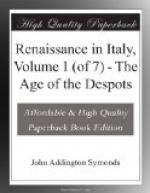Then the noose was tightened round his neck. The
fire beneath was lighted. The flames did not
reach his body while life was in it; but those who
gazed intently thought they saw the right hand give
the sign of benediction. A little child afterwards
saw his heart still whole among the ashes cast into
the Arno; and almost to this day flowers have been
placed every morning of the 23d of May upon the slab
of the Piazza where his body fell.
[1] There seems to be no doubt that this Ordeal by Fire was finally got up by the Compagnacci with the sanction of the Signory, who were anxious to relieve themselves by any means of Savonarola. The Franciscan chosen to enter the flames together with Fra Domenico was a certain Giuliano Rondinelli. Nardi calls him Andrea Rondinelli.
[2] Nardi, lib. ii. vol. i. p. 128, treats the whole matter of Savonarola’s confessions under torture with good sense. He says: ’Avendo domandato il frate quello che diceva e affermava delle sue esamine fatte infino a quel di, rispose, che cio ch’ egli aveva ne’ tempi passati detto e predetto era la pura verita, e che quello di che s’era ridetto e aveva ritratto, era tutto falso e era seguito per il dolor grande e per la paura che egli aveva de’ tormenti, e che di nuovo si ridirebbe e ritratterebbe tante volte, quante ci fusse di nuovo tormentato, percio che si conosceva molto debole e inconstante nel sopportare i supplicii.’ Burchard, in his Diary, reports the childish, foul, malignant gossip current in Rome. This may be read in the ‘Preuves et Observations’ appended to the Memoirs of De Comines, vol. v. p. 512. See the Marchese Gino Capponi’s Storia della Firenze (tom. ii. pp. 248-51) for a critical analysis of the depositions falsely ascribed to Savonarola.
[3] There is a curious old picture in the Pinacoteca of Perugia which represents the burning of the three friars. The whole Piazza della Signoria is shown, with the houses of the fifteenth century, and without the statues which afterwards adorned it. The spectator fronts the Palazzo, and has to his extreme right the Loggia de’ Lanzi. The center of the square is occupied by a great circular pile of billets and fagots, to which a wooden bridge of scaffolding leads from the left angle of the Polazzo. From the middle of the pile rises a pole, to which the bodies of the friars in their white clothes are suspended. Sta Maria del Fiore, the Badia tower, and the distant hills above Fiesole complete a scene which is no doubt accurate in detail.
Thus died Savonarola: and immediately he became a saint. His sermons and other works were universally distributed. Medals in his honor were struck. Raphael painted him among the Doctors of the Church in the Camera della Segnatura of the Vatican. The Church, with strange inconsistency, proposed to canonize the man whom she had burned as a contumacious heretic and a corrupter of the people. This canonization




